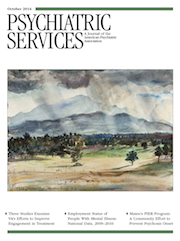Efforts to Reduce Seclusion and Restraint Use in a State Psychiatric Hospital: A Ten-Year Perspective
Abstract
Objective
The authors previously demonstrated an 82.3% reduction in seclusion and restraint use at an inpatient psychiatric facility, largely attributable to changes to the physical environment. This study investigated whether the reduction was sustained over time.
Methods
This follow-up study examined archival data by using a longer preintervention baseline phase and examined the sustainability of intervention gains in the absence of a research agenda. Over ten years, 3,040 seclusion and restraint incidents were analyzed across 254,491 patient-days.
Results
The extended baseline phase (N=38 months) exhibited a linear trend upward in seclusion and restraint use, and the formal intervention period and subsequent follow-up periods (N=82 months) showed a stabilization effect (p<.001).
Conclusions
The findings suggest that reduction in seclusion and restraint use is sustainable, and judicious use of seclusion and restraint can become the new normative practice—even in the face of potentially disruptive administrative and environmental changes.



